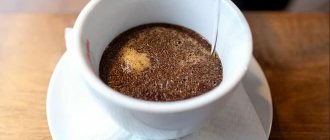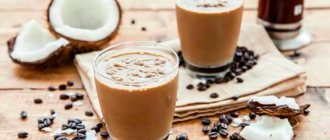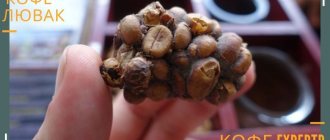History of coffee production Barista
The owner of the AVD Production enterprise, Oktay Iskenderov, decided in 2000 to open a plant near Minsk, in Vishnevka, to produce a new coffee brand, and invited Italian specialists to install the equipment.
Coffee lovers in Ukraine and Russia liked the special taste and price. Professionals also appreciated the product presented at the international forum.
I also liked the three-layer, sealed packaging, equipped with special fasteners. Even opened bags retain all the coffee aromas and taste properties of the product.
In 2011, a subsidiary was founded with its head office in St. Petersburg. It belongs to the coffee industry of the parent concern Soyuz Corporation, under the Soyuz Coffee Roasting brand. With the production of “specialty coffee” already in Kaliningrad.
Range
The Barista range includes a line of ground coffee and a professional series of beans for cafes, bars and restaurants. The products are packaged in vacuum briquettes and multilayer foil bags of varying weights from 100 grams to 1000. Instant coffee is not yet included in the range.
Collection for general consumption
Includes 4 types of ground coffee:
- classical;
- for a cup;
- espresso;
- traditional.
The classic one in a green pack is represented by a mixture of Brazilian and Indian Arabica beans, the beans of which have been Viennese roasted and finely ground. The product is suitable for cooking in a cup or pot.
Coffee for a cup in a red pack is a combination of Arabica beans from Asia and America, giving a unique multifaceted taste and aroma. The beans are urban roasted and medium ground.
Barista ground espresso – coffee made according to all the traditions of Italian espresso. This is high-quality Brazilian Arabica with a share of Robusta, which are carefully and deeply roasted and finely ground to obtain that very strong and aromatic drink. This espresso can be prepared in a cup.
Traditional barista - coffee for lovers of a mild taste with a slight bitterness. Medium roast, medium ground, light and flavorful. Variety Santos Brazil. This coffee can be prepared in a cup, Turkish coffee maker, drip coffee maker and French press.
Professional series Barista Pro
This line of coffee beans is intended for professional or home use. Specially developed mixtures of different types of coffee beans are carefully packaged in multi-layer packaging with a bypass valve.
The collection includes:
Coffee Tchibo
- Barista Pro Bar is a harmonious blend of Arabica and Robusta from India, Africa and South America for professional coffee machines. The beans are medium roasted and have a pleasant chocolate hue in taste and aroma;
- Barista Pro Vending - a mixture of Arabica and Robusta for vending coffee machines, gives a rich, high-density taste;
- BARISTA PRO CREMA – aromatic Arabica from Costa Rica dominates here, giving a pleasant berry-cream taste with a bright bitterness;
- BARISTA PRO SPECIALE – Arabica beans from Mexico give this product unusual spicy notes. The drink has a pleasant sourness and sweet aroma.
Each product from this collection undergoes a specially designed roasting option in order to achieve the desired taste and aroma characteristics.
Proper three-layer packaging with a valve allows the grains to retain their aroma and ripen with the release of the resulting gases. Barista is the coffee that has the makings of getting the title of a good brand. Competent specialists, reasonable prices and decent quality make it a contender for leadership in the domestic market.
Purchase of raw materials and features of coffee production Barista
Green beans are purchased at:
- Indian,
- Latin American,
- African and other plantations, not with mass deliveries, but purely on personal contacts.
These beans are harvested only by hand, using different processing methods. After sorting, the products go directly from the supplier to the company's plant. Here, using different blends, the coffee is roasted and dried.
When dried, bean grains can be removed from the pulp and peel or peeled and washed. Different approaches to this process give different tastes to the beans. They are obtained either with a rich, spicy taste or, with the second method, with a clean, transparent coffee taste and sourness.
Separation of grains is their thorough cleaning, with the removal of foreign objects using a magnetic method, because 1 ton of raw materials may contain:
- iron - 1 kg;
- stones - up to several kg;
- other impurities.
Barista coffee is roasted in several cycles. One cycle processes 500 kg of beans. The moisture content of the raw materials is taken into account here.
Foreign specialists do the roasting at the plant. Because roasting is a real art, and it needs to be learned.
After roasting, different types of roasted coffee are sent for storage in their own separate bunker. Then the recipe parameters are verified, and a computer program is created for them to determine the number of grains and proportions for mixing in a common container.
Grinding is done in a mill whose millstones are very sensitive to foreign objects. They, moving apart, immediately throw them away.
Thanks to a vacuum machine, briquettes are formed using packaging film, taking into account its porosity and paint composition. This packaging system is the property of the enterprise.
Raw grains and production process
The company purchases beans from almost all countries where green coffee grows: India, Latin America, Africa, etc. Thanks to partnership agreements, suppliers provide only the highest quality raw materials, carefully selected by hand and processed depending on the taste of the coffee in the future. For example, some beans are supplied in peels, which, when dried, gives them a fruity sourness and spicy aroma. For a classic taste, the beans are cleared of pulp and washed before being sent to production.
Raw materials are purchased from Brazil, India, Africa
The blends are developed by professionals in their field. To reveal the unique taste of coffee, they experiment with roasting methods and create unique combinations of varieties.
Before going for roasting, the beans undergo thorough cleaning: possible foreign objects are removed from them in several stages, one of the most important is magnetic, which allows you to detect metal objects. According to the company's technologist, a ton of beans contains about a kilogram of iron and several kilograms of stones, and this is with the exception of other impurities.
The process of cleaning and processing grains
After separation - roasting in a cast iron oven. Up to 500 kg of grains are processed in one cycle. When choosing the duration and temperature of processing, take into account how wet the raw material is. This is a real art, because it is so important to correctly determine the readiness of the grain so that it does not remain raw or burnt. It is noteworthy that all the roasters at the Barista plant are foreigners. The owner of the company explains this by saying that this is not taught in Belarus, and therefore there are no specialists of this kind.
Different varieties are roasted and stored separately: bunkers are equipped for this. After the recipe has been verified, its parameters are entered into a computer program, which determines how much grain and in what proportions to mix in a common vat.
Roasting coffee is a very responsible task.
Next - silence. The mill is designed in such a way that the millstones move apart when foreign objects enter to throw them out, and then come together again. The coffee is then ground.
Ground grain must undergo degassing, this allows carbon dioxide to be removed. Special cameras are installed for this purpose. The raw materials can spend up to two days there.
Finally, packaging. A vacuum machine forms a briquette from the product using packaging film. Barista has developed its own packaging system, which takes into account everything from the porosity of the film to the composition of the paints.
Determination of grain moisture content
Despite the fact that the company is represented by one plant, consulting statistics indicate that Barista products occupy 25% of the coffee market share in Belarus and up to 12% in export countries, which is very significant for such a small production. In addition to Russia and Ukraine, targeted supplies have been established to the USA and Iran.
The plant has a laboratory that samples grain that is grown all over the world. Suppliers change depending on market conditions, yields and quality of raw materials. Marketers study the demand and tastes of consumers, and chemists study the composition of grains and types of frying to determine the taste of the drink.
Where is Barista coffee sold and its cost?
This is an elite product, so it is created for connoisseurs of good coffee.
- 500 rub. you need to pay for a package of 250 g.
- 1600 - 1700 rub. There are packs of 1 kg of product.
Often this product is on sale.
It is sold in chain stores in the western and central regions of the country:
- In Lenta,
- Magnet,
- Carousels,
- Metro,
- Selgrosse,
- Holiday.
And also in online stores, with delivery throughout Russia.
What is the highlight of a Barista?
The most important secret of the perfect taste of the drink is high-quality selected grains. One product contains elite varieties of Robusta and Arabica, which produce aromatic, delicious espresso. For its production, Brazilian, Indian, Kenyan and American coffee beans are used. This mixture allows you to get a drink with a pleasant sourness or pronounced bitterness.
They produce products using the latest technologies on Italian equipment. Freshly roasted beans undergo special quality control, because only in Belarus there is a laboratory that monitors the quality of the product.
The Belarusian manufacturer is responsible for high-grade raw materials, the freshness of the product and the excellent taste and aroma properties of the produced coffee.
Today, Barista has become very famous due to its decent quality and affordable price.
What consumers say about Barista
Those who have tried this brand’s coffee at least once will remember it forever. They speak very highly of him. This is not mass production.
She is expensive. Designed for those who can distinguish good coffee from bad. In coffee shops that work with a special combination of coffee, you can also enjoy such drinks.
Oleg works as a barista in a coffee shop: “Barista is the best brand. I love making coffee like this. It has a special long-lasting aroma and taste. At home I also make coffee only from this brand.”
Alexander, manager: “I looked at the brand and the coffee and decided it was expensive. But I took a photo of the packaging. I found information about it on the Internet and bought it. There are simply no words for how great he is. I haven’t drunk anything like this before.”
Barista range
Manufacturers have taken care to please every consumer. The Barista assortment includes five blends (coffee mixtures) for people with different tastes. Each coffee is individual and differs from others in a certain degree of roasting, grinding and composition.
The barista produces ground coffee and grains, which are purchased for restaurants and cafes. The product can be purchased in briquettes and in foil bags, weighing from one hundred grams to one kilogram.
The barista produces an exclusive product, which consists of elite Arabica varieties.
Barista: who is he? What does he do?
The specialist who stands behind the bar is called a “barista” (translated from Italian). But this is not so, a barista is a worker who prepares coffee well in a coffee machine and knows how to serve it correctly.
The barista brews natural bean coffee and also knows how to prepare other coffee drinks based on it. In Italy, this profession is highly valued; people learn what they love and know all the nuances of processing and methods of collecting coffee beans.
A “master barista” is a specialist who brews real espresso. You can prepare coffee using several methods: drip, pour and brew with water, boil, filter, cook under pressure. By brewing using the latter method, you can get real espresso, which is served in all coffee shops, bars and restaurants.
Each type of coffee needs to be brewed in a specific way to get the perfect drink. The quality of the finished coffee is influenced by the following factors: the freshness of the beans, the degree of grinding, water and the functions of the coffee machine. A barista can easily determine the pros and cons of espresso. A real Barista brew should have a gently creamy foam that does not settle.
Baristas must have the following qualities:
- Politeness and friendliness;
- Communication skills, because they work with people;
- Sociability;
- Professional skills and responsibility.
Russian baristas are boys and girls under the age of thirty. Mostly these are representatives of the fairer sex between the ages of eighteen and twenty-five. A real barista must be able to prepare up to forty types of coffee drinks. Must also be proficient in latte art, which means drawing on coffee foam.











